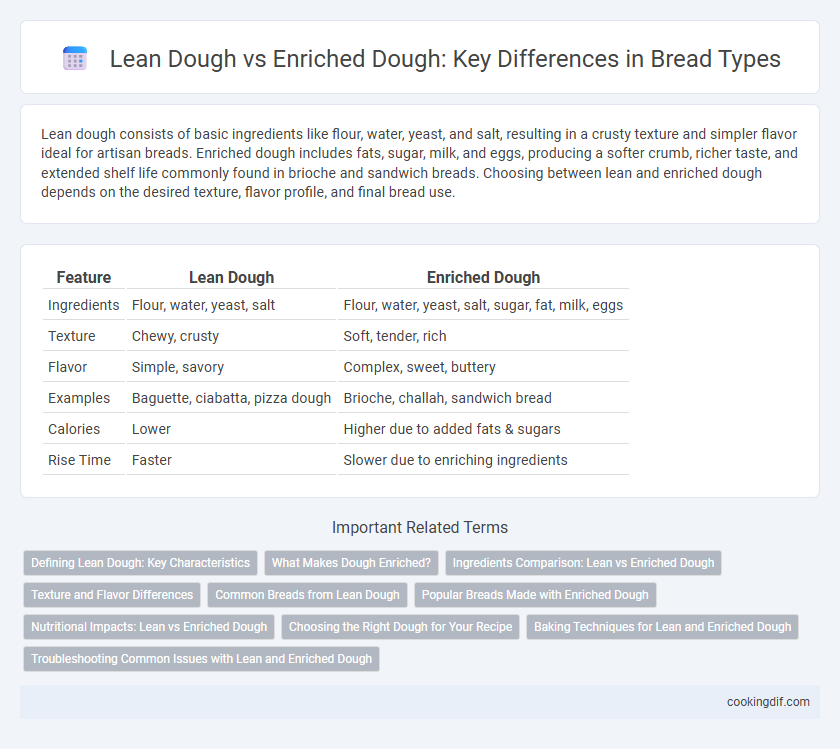Lean dough consists of basic ingredients like flour, water, yeast, and salt, resulting in a crusty texture and simpler flavor ideal for artisan breads. Enriched dough includes fats, sugar, milk, and eggs, producing a softer crumb, richer taste, and extended shelf life commonly found in brioche and sandwich breads. Choosing between lean and enriched dough depends on the desired texture, flavor profile, and final bread use.
Table of Comparison
| Feature | Lean Dough | Enriched Dough |
|---|---|---|
| Ingredients | Flour, water, yeast, salt | Flour, water, yeast, salt, sugar, fat, milk, eggs |
| Texture | Chewy, crusty | Soft, tender, rich |
| Flavor | Simple, savory | Complex, sweet, buttery |
| Examples | Baguette, ciabatta, pizza dough | Brioche, challah, sandwich bread |
| Calories | Lower | Higher due to added fats & sugars |
| Rise Time | Faster | Slower due to enriching ingredients |
Defining Lean Dough: Key Characteristics
Lean dough consists primarily of flour, water, yeast, and salt, containing little to no fat, sugar, or dairy, resulting in a crusty texture and chewier crumb. This type of dough is commonly used in artisan breads like baguettes and ciabatta, where the focus is on highlighting natural fermentation flavors. The absence of enriching ingredients allows for a longer fermentation process, enhancing gluten development and producing a more robust, tangy bread profile.
What Makes Dough Enriched?
Enriched dough contains added ingredients such as fats, sugars, milk, and eggs, which enhance flavor, texture, and color compared to lean dough that primarily consists of flour, water, yeast, and salt. The presence of fats like butter or oil tenderizes the crumb, while eggs contribute to richness and structure, making enriched dough ideal for soft, fluffy breads like brioche and challah. Sugar not only feeds the yeast for fermentation but also promotes browning during baking, distinguishing enriched dough from the more basic lean dough varieties.
Ingredients Comparison: Lean vs Enriched Dough
Lean dough primarily contains flour, water, yeast, and salt, resulting in a simple and crusty bread with a chewy texture. Enriched dough incorporates additional ingredients such as sugar, butter, eggs, and milk, enhancing flavor, softness, and shelf life. The higher fat and sugar content in enriched dough contributes to a tender crumb and richer taste compared to the lean dough's more rustic and hearty profile.
Texture and Flavor Differences
Lean dough, made from basic ingredients like flour, water, yeast, and salt, produces bread with a chewier texture and a more straightforward, slightly tangy flavor due to minimal fat and sugar. Enriched dough incorporates fats, sugars, milk, and sometimes eggs, creating a softer, richer crumb with a tender texture and a sweeter, more complex flavor profile. The fat and sugar in enriched dough tenderize the gluten structure, resulting in a moist, fluffy loaf compared to the denser, crisper crust found in lean dough breads.
Common Breads from Lean Dough
Lean dough, characterized by its minimal ingredients--typically flour, water, yeast, and salt--is the foundation for common breads like baguettes, ciabatta, and sourdough. These breads rely on fermentation and baking techniques to develop flavor and texture without added fats, sugars, or dairy found in enriched dough varieties. Lean dough produces a crisp crust and open crumb, making it ideal for traditional artisan and rustic bread types widely consumed worldwide.
Popular Breads Made with Enriched Dough
Popular breads made with enriched dough include brioche, challah, and cinnamon rolls, all known for their tender crumb and rich flavor. Enriched dough contains higher levels of butter, eggs, milk, and sugar, contributing to its soft texture and golden crust. This contrasts with lean dough, which is typically used for crusty breads like baguettes due to its minimal fat and sugar content.
Nutritional Impacts: Lean vs Enriched Dough
Lean dough, composed primarily of flour, water, yeast, and salt, offers a lower calorie and fat content, making it a healthier choice for those seeking reduced dietary fats and simpler nutrition. Enriched dough incorporates ingredients like milk, eggs, sugar, and butter, increasing its protein, vitamin, and mineral content but also elevating sugar and fat levels, which affects its caloric density. Choosing between lean and enriched dough depends on dietary goals, with lean dough favoring lower fat intake and enriched dough providing enhanced nutrient complexity.
Choosing the Right Dough for Your Recipe
Lean dough, made with basic ingredients like flour, water, yeast, and salt, produces a crusty, airy bread ideal for rustic loaves such as baguettes and ciabatta. Enriched dough contains added fats, sugars, eggs, or dairy, resulting in a softer crumb and richer flavor suited for brioche, challah, or sandwich bread. Choosing the right dough depends on the desired texture, flavor, and bread type, influencing both baking time and ingredient ratios significantly.
Baking Techniques for Lean and Enriched Dough
Lean dough, containing only flour, water, yeast, and salt, requires precise fermentation control and strong gluten development to achieve a crisp crust and open crumb, making techniques like longer autolyse and stretch-and-fold essential. Enriched dough incorporates fats, sugars, and dairy, demanding gentler mixing and slower fermentation to prevent gluten breakdown and ensure a tender, soft texture with enhanced flavor. Mastering temperature control and fermentation timing is crucial in both dough types to optimize rise and crumb structure during baking.
Troubleshooting Common Issues with Lean and Enriched Dough
Lean dough, composed primarily of flour, water, yeast, and salt, often faces issues like dryness and poor rise due to its low fat and sugar content, making proper hydration and fermentation critical to troubleshoot. Enriched dough contains fats, sugars, and dairy, which can cause stickiness and over-proofing, requiring careful temperature control and precise ingredient measurement to maintain texture and structure. Balancing hydration levels and fermentation times is essential for resolving common problems in both dough types and achieving consistent bread quality.
Lean Dough vs Enriched Dough for type Infographic

 cookingdif.com
cookingdif.com